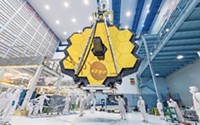Advertisement
Grab your lab coat. Let's get started
Welcome!
Welcome!
Create an account below to get 6 C&EN articles per month, receive newsletters and more - all free.
It seems this is your first time logging in online. Please enter the following information to continue.
As an ACS member you automatically get access to this site. All we need is few more details to create your reading experience.
Not you? Sign in with a different account.
Not you? Sign in with a different account.
ERROR 1
ERROR 1
ERROR 2
ERROR 2
ERROR 2
ERROR 2
ERROR 2
Password and Confirm password must match.
If you have an ACS member number, please enter it here so we can link this account to your membership. (optional)
ERROR 2
ACS values your privacy. By submitting your information, you are gaining access to C&EN and subscribing to our weekly newsletter. We use the information you provide to make your reading experience better, and we will never sell your data to third party members.
Astrochemistry
What can we learn from Venus?
Planned and proposed missions to Earth’s nearest neighbor could help scientists understand distant exoplanets’ chemistry
by Sam Lemonick
March 27, 2021
| A version of this story appeared in
Volume 99, Issue 11

If you’re a Venus fan, all the recent attention on Mars rovers may have you a bit jealous. But our relationship with our nearest planetary neighbor could be changing, with some researchers seeing it follow the on-again, off-again relationship we’ve had with Mars.
In the 1960s and 1970s, the US and USSR sent dozens of landers and orbiters to Mars. By the end of that period of exploration, the broad consensus among scientists was that Mars had little or no chemical evidence of life or habitability and was geologically dead. That conclusion cooled enthusiasm for Mars exploration. It was 20 years until another rover landed on the planet. But with new results from that 1996 mission, including evidence of a wetter past, interest in Mars quickly rebounded. In the past 25 years, humans have launched 23 missions to Mars.
In the 1950s and 1960s, before the first Mars craze, some scientists thought that Venus was the more attractive target to explore because it’s closer to Earth than Mars and cheaper to get to. Also, from Earth, Venus’s atmosphere looks a fair amount like our own. But a series of USSR landers and NASA orbiters launched through the late 1980s told a different story. They found the surface of Venus is more than 450 °C, and its atmospheric pressure is almost 100 times that of Earth’s. As a result of those discoveries, scientists largely closed the book on Venus, says Richard Ghail of Royal Holloway, University of London, and missions tailed off.
But then the European Space Agency’s 2005 Venus Express orbiter found hydroxyl in Venus’s atmosphere along with other clues that its chemistry may be more complex than previously thought. Japan’s 2010 Akatsuki orbiter revealed previously unknown atmospheric structure and dynamics. And recent data from the planet support the idea that Venus holds more interesting surprises. Last June, scientists announced that Venus has more nitrogen in parts of its atmosphere than models predicted, and in September, a group announced that it found phosphine—a possible sign of life—in Venus’s clouds, although researchers are debating those results.
“I naively thought we knew the atmosphere quite well,” astrochemist Clara Sousa-Silva of the Massachusetts Institute of Technology says. “We know f--- all about Venus.”
Besides filling in the blanks in our venusian knowledge, some scientists also want to use our sister planet as a proving ground for the techniques they will need to decipher the chemistry of planets beyond our solar system.
So scientists and space agencies are suddenly interested in missions to Venus again. Ghail, drawing a comparison to the resurgence in Mars exploration 25 years ago, says, “Venus, I think, is approaching that next phase.”
Several space agencies around the world are now making plans for their next Venus mission. The Indian Space Research Organization (ISRO) plans to launch an orbiter in 2024. The Russian federal space agency, Roscosmos, has proposed a new lander for 2029. NASA and the European Space Agency (ESA) are in the final stages of considering several proposals for new Venus missions. China’s space agency may be thinking about a mission of its own. There’s even a private company, Rocket Lab, working on a trip to Venus.
This next wave of Venus exploration will likely focus more on studying Venus’s geology than its atmospheric chemistry. Those geological questions are easier to answer with current technology for instruments and spacecraft. But missions in the latter half of this decade, like Russia’s proposed Venera-D, could include landers or balloons that will directly observe the planet’s clouds and surface.
India is the only country with a confirmed Venus mission. ISRO plans to launch its Shukrayaan-1 orbiter in 2024 for a mission lasting about 4 years. The agency has released little information to the public, but news reports suggest the orbiter will carry a radar instrument adapted from ISRO’s current moon mission to study the planet’s surface. ISRO did not respond to multiple requests from C&EN for an interview. The craft will also carry an infrared spectrometer developed by French and Russian researchers to study atmospheric chemistry and a Swedish instrument to study solar particles impacting the atmosphere. ISRO is still considering other proposed instruments.
NASA is weighing two possible Venus missions. DAVINCI+ (Deep Atmosphere of Venus Investigation of Noble Gases, Chemistry, and Imaging, Plus) would study Venus’s atmosphere, incorporating an orbiter with ultraviolet and near-infrared spectrometers to observe chemicals in the upper atmosphere as well as a probe with a mass spectrometer and a laser spectrometer. The probe would measure carbon monoxide, carbonyl sulfide, sulfur dioxide, and other species as it descends toward the planet’s surface, creating a full temperature, pressure, and composition profile of the atmosphere. The planet’s harsh conditions will likely destroy the instruments before the probe touches down.

The second candidate NASA mission is VERITAS (Venus Emissivity, Radio Science, InSAR, Topography, and Spectroscopy), which is focused on geology. It would carry radar to map the surface and a spectrometer to try to characterize rocks and minerals. Proposed principal investigator Suzanne E. Smrekar of NASA’s Jet Propulsion Laboratory says these observations could help explain how rocky planets evolve and why Earth and Venus ended up so different despite starting somewhat similarly. Geological processes like volcanoes—which Venus has—and plate tectonics—which it doesn’t—are also linked to atmospheric chemistry, so Smrekar sees VERITAS’s geological studies as one important part of understanding Venus’s chemistry.
On June 2, NASA announced that it had selected both DAVINCI+ and VERITAS as missions to explore Venus and that each will launch between 2028 and 2030.
ESA’s proposed EnVision orbiter would look more closely at Venus’s geochemistry. Ghail, who is part of the EnVision team, says scientists hope to get as much scientific equipment on the spacecraft as they can, including radar to map the surface and IR and UV spectrometers to identify chemicals at the surface, in the clouds, and possibly in volcanic gases. The goal, he says, is to understand the makeup of Venus’s geology and atmosphere, how the two interact, and how they changed over time to create such a seemingly inhospitable environment. These studies could include answering whether the planet was ever habitable.
Russia’s Venera-D mission is more ambitious. It has also been delayed several times, and Roscosmos now says it couldn’t launch before 2029. Venera-D could include an orbiter with radar and IR and UV spectrometers to study the atmosphere, and a lander with a spectrometer and a gas chromatograph/mass spectrometer. A mission proposal in 2004 also included balloons to sample clouds, although those have since been scrapped.
Rocket Lab, which has been launching small satellites into Earth orbit for clients, says it’s working with scientists including MIT’s Sara Seager to send a small probe into Venus’s atmosphere. Seager is one of the researchers behind last year’s possible phosphine discovery. Rocket Lab has not said what instruments it plans to include on the mission, but the proposed payload capacity suggests the craft may not be large enough to carry a complex instrument like a mass spectrometer. The company has said that it hopes the mission will be much less expensive than traditional government-led missions and that the smaller price tag will allow for more exploration of the planet.
Stephen Kane of the University of California, Riverside, who is a member of the DAVINCI+ team, thinks one of the best arguments for Venus missions is that they will help us understand exoplanets. He says Venus and Earth likely looked very similar for most of their history but have radically diverged, maybe only in the past 715 million years. “That’s of fundamental importance to understanding the prevalence of life in the universe,” he says.
He says Venus gives us a chance to use remote observations to build models of a planet’s atmospheric chemistry and then test those assumptions with spacecraft that directly analyze the planet. And our planetary climate models, he says, are lacking. They fail to predict how Venus evolved from a temperate climate to its current state, and they can’t even describe the current chemistry of the planet’s lower and middle atmospheres.
“We’re never going to send a probe to Proxima Centauri b,” which at 4.2 light-years away is one of the closest exoplanets to Earth, Kane says. If we can’t model our closest neighbor, he says, we have no chance to model a planet we can barely see orbiting a distant star.
Update
This story was updated on June 3, 2021, to include information about NASA's June 2, 2021, announcement of new missions to explore Venus.





Join the conversation
Contact the reporter
Submit a Letter to the Editor for publication
Engage with us on Twitter